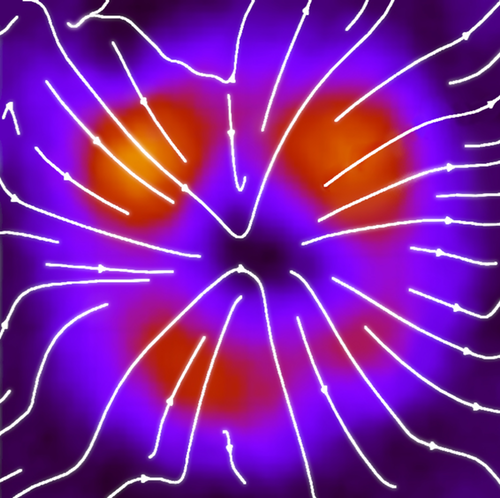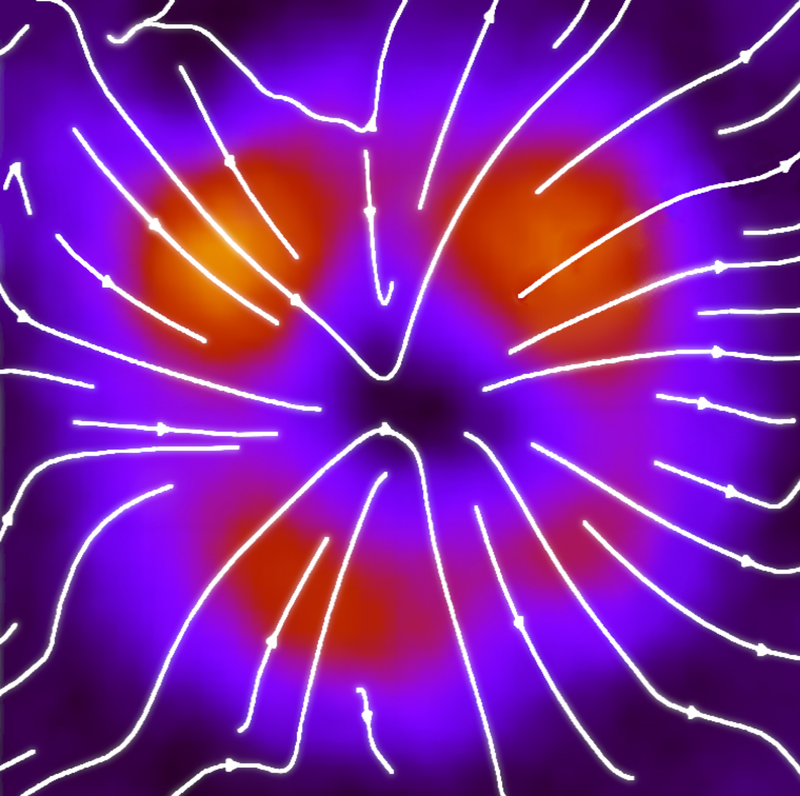Vortices of Light on the Cheap
Vector vortex laser beams have a unique polarization pattern that varies with position around a dark center, and this nonuniformity can, for example, lead to tighter focusing than is possible with the usual uniform polarization. Now researchers have produced vector vortices using just a low-cost laser along with a reflecting element, bypassing the usual specialized equipment. This relatively simple design could allow switching between different polarization patterns with a small change to the laser current.
Vector vortices are similar to optical vortices; both have beam cross sections with a donut-shaped intensity pattern. In an optical vortex, the light’s phase varies around the dark hole in the center of the beam, while the polarization direction is uniform. But in a vector vortex beam it’s the polarization that changes as you move around the center. Researchers have shown that a beam with varying polarization can be focused to a smaller spot size than a beam with uniform polarization [1]. This tight focusing could benefit optical trapping and light-based etching techniques. Researchers are also exploring correlation properties of vector vortices, which resemble quantum entanglement.
One of the most common methods for producing vector vortices is to use a liquid-crystal spatial light modulator that can impose a polarization direction at specific points in the cross section of a beam. Other elements, such as cone-shaped reflectors, can also be inserted into a beam’s path to generate nonuniform polarization configurations. But a simpler method has now been revealed by Thorsten Ackemann of the University of Strathclyde in Glasgow, UK, and his colleagues. The team discovered that a type of semiconductor laser—specifically, a vertical-cavity surface-emitting laser (VCSEL)—could produce a variety of different vector vortices when aimed at a frequency-specific mirror. “You don’t need to engineer these polarization states,” Ackemann says. “They arise spontaneously.”
The potential for generating vector vortices with a VCSEL was predicted twenty years ago [2]. The reasoning then was based on the highly symmetric character of a VCSEL lasing cavity. Most lasers are not symmetric—for example, they may have rectangular cross sections—and this asymmetry largely determines the polarization direction of the emitted light. By contrast, a VCSEL emits from a cylindrical cavity, so the polarization can often switch between, say, horizontal and vertical directions. This polarization “competition” suggests that there might be intermediate states where the two polarization modes coexist to form a spatially nonuniform pattern. Ackemann suspects that no previous experiments had detected a nonuniform polarization (vector vortex) because VCSELs have just enough asymmetry that one polarization mode always wins—at least for a little while before switching to the other.
In their system, Ackemann and his colleagues were able to compensate for the intrinsic asymmetry of their VCSEL by adding a volume Bragg grating (VBG)—essentially a mirror that only reflects one frequency. The VBG, which was placed in front of the VCSEL, created a new resonance cavity between the reflecting surface and the emitting surface of the laser. The feedback from this cavity helped to lock the laser frequency at the reflection frequency. As the team varied the current supplied to the VCSEL (which affects the beam’s intensity and frequency), they were surprised to find that the polarization became nonuniform. The reason for this change is not entirely clear, but Ackemann believes that minute tilts of the VBG can offset laser-based anisotropies and force multiple polarization modes to have the same frequency, so that none dominates.
The observed polarization configurations depended on the current supplied to the VCSEL. For most values, the polarization stayed uniform, but for certain current inputs, the team recorded vortices with radial, hyperbolic, or spiral patterns. This dependence on current, which is linked to temperature-induced changes in the resonant frequency of the VCSEL-VBG cavity, might be used in future devices to switch vortices on and off. Such control is possible with spatial light modulators, but these devices are expensive.
Qiwen Zhan of the University of Dayton in Ohio says that creating vector vortices with a VCSEL could be useful in many applications, with the main advantages being “the compactness of the device and the capability of adjusting the nonuniform polarization states through electrical tuning.” However, he agrees with the authors that applications will have to wait for a more comprehensive study of the VCSEL-VBG resonance cavity to understand the mechanisms that lead to vortex formation.
This research is published in Physical Review Letters.
–Michael Schirber
Michael Schirber is a Corresponding Editor for Physics Magazine based in Lyon, France.
References
- R. Dorn, S. Quabis, and G. Leuchs, “Sharper Focus for a Radially Polarized Light Beam,” Phys. Rev. Lett. 91, 233901 (2003).
- F. Prati, G. Tissoni, M. San Miguel, and N. B. Abraham, “Vector Vortices and Polarization State of Low-Order Transverse Modes in a VCSEL,” Opt. Commun. 143, 133 (1997).





